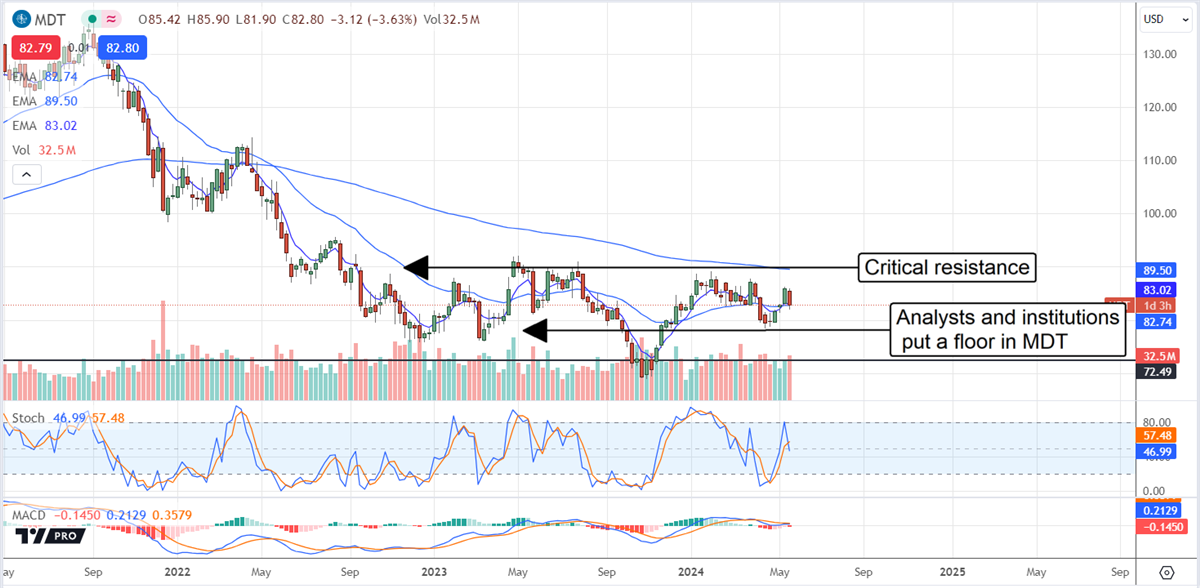Ticker Reports for May 26th
Micron Stock: Even With A 150% Gain, Analysts Want More
Shares of Micron Technology (NASDAQ: MU) have been enjoying a remarkable rally, with its stock effectively doubling over the past 12 months alone. Since the start of 2023, its shares have jumped 150%. For the most part, this eye-watering rally has been driven by the company's strategic positioning in the artificial intelligence (AI) industry, which has blossomed, if not exploded, in that timeframe.
For those of us watching from the sidelines, you'd be forgiven for thinking you might have missed the boat. Just this morning, for example, the stock hit a fresh high, and it could soon find itself in blue-sky territory. Despite these impressive gains, however, several heavyweight analysts continue to call Micron a screaming buy, and readers should be excited.
Bullish Calls For Micron Shares
Take Morgan Stanley, for example. Earlier this week, the team upped its rating on Micron shares, citing its significant exposure to the AI memory market. The firm also raised its price target on Micron's stock, acknowledging the underestimated economic and narrative elements of AI memory.
This echoed Mizuho's move last week when they reiterated their Buy rating and gave Micron a price target of $150. Before them, Barclays and Baird were bullish on Micron's potential, with the latter adding it to its list of top semiconductor ideas.
The Baird team highlighted the "meaningful upside opportunities" ahead, especially in light of recent pullbacks, allowing shares to take a breather. They anticipate an unprecedented outlook for the memory market over the next 12-18 months, driven by stronger-than-expected Dynamic Random-Access Memory (DRAM) pricing and the potential for high gross margins from HBM3E products.
Micron's Strong Fundamentals
This demand for high-performance memory solutions, driven by the AI revolution, has positioned Micron as a key player in the overall market, ahead of most of its peers. All the signs are there that the company intends to take full advantage of this. Recently, they announced an increase in their capital expenditure forecast for the year, from $7.5 billion to $8 billion, primarily to support their expansion in AI-related technologies.
At recent conferences, Micron executives have highlighted the company's expectations for high-bandwidth memory to become a multi-billion dollar business by 2025. It's perhaps no real surprise that Micron has a street-high price target of $150, which currently points to further upside in the region of 20%.
Beyond the company-specific tailwinds driving the share price higher, Micron is also set to continue benefiting from strong industry tailwinds that are only getting stronger. The Citi team came out bullish on the sector as a whole, particularly Micron, earlier this month, citing an industry report showing that sales are well above seasonal sales figures.
Getting Involved In Micron Stock
According to the Semiconductor Industry Association, March sales were $50.6 billion, up more than 16% monthly and more than 15% year over year. That was above Citi's estimated $50.1 billion and the seasonal estimate for a 12% month-over-month increase and a 14% annual increase.
All told, investors should watch Micron closely for an entry opportunity as it feels the stars are continuing to align on its growth prospects. One way to do this might be to look for the stock to close above $130, something it has yet to do, to confirm a breakout is beginning.
Alternatively, if shares continue to pull back from their latest push for a record close, look for them to consolidate above the $115 mark, supporting the technical thesis backing up the stock.
$5,000 Gold?
Former Wall Street Banker Reveals Mysterious Gold Leverage
As gold continues to soar, this ex-Goldman Sachs VP says DON'T buy bullion or mining stocks. Instead, he's just shared a "gold bank" that uses about $10 of your money to harness the power of two ounces of pure gold (worth about $4,200 right now).
TD Bank Q2 Earnings: Record Highs and Regulatory Hurdles
TD Bank Group (NYSE: TD) (TSE: TD) is a prominent player in the Canadian and North American financial services sector. TD Bank’s earnings report for the second quarter of 2024 was recently unveiled, revealing TD Bank’s financial performance during the quarter. This earnings report holds significant weight for investors, offering a detailed glimpse into the bank's operational resilience and strategic direction against a complex economic backdrop.
TD Bank Group navigates a dynamic business environment characterized by persistent inflationary pressures, rising interest rates, and lingering recessionary concerns. How do these economic realities impact TD Bank’s bottom line, and what strategy is the company employing to navigate these choppy waters?
TD Bank’s Financial Scorecard and Key Metrics
TD Bank Group's latest earnings report showed adjusted earnings per share (EPS) of $1.49 for Q2 2024, exceeding analyst expectations of $1.35. This figure demonstrates an increase compared to the previous quarter's adjusted EPS of $1.46 and the year-ago quarter's $1.40. On a reported basis, diluted earnings per share were $0.99, reflecting a decline from $1.23 in the same period last year.
This disparity between adjusted and reported earnings stems primarily from significant items impacting the quarter, most notably a substantial provision related to ongoing investigations into the bank's anti-money laundering (AML) program.
Net income, a crucial indicator of profitability, provides similar performance. TD Bank Group recorded an adjusted net income of $2.77 billion for Q2 2024, marking a modest increase from $2.71 billion in the year-ago quarter. However, the company’s reported net income decreased to $1.87 billion compared to $2.42 billion in Q2 2023.
The bank's revenue for Q2 2024 reached $10.10 billion, surpassing analyst forecasts of $9.26 billion and demonstrating growth compared to the previous quarter's $10.02 billion and the year-ago quarter's $9.06 billion. This positive revenue trend is attributed to solid performance across most of the bank's business segments, driven by loan and deposit growth, expanding net interest margins in certain areas, and robust capital markets activity.
Provision for credit losses, an expense reflecting the bank's expectation of potential loan defaults, increased to $781.8 million in Q2 2024 compared to $730 billion in the prior quarter and $438.4 million in the same period last year. This upward trend underscores a more cautious stance on credit risk, likely influenced by concerns about a potential economic slowdown and its impact on borrower repayment capacity.
Return on equity (ROE), a key measure of financial performance and efficiency, stood at an adjusted 14.5% for Q2 2024, indicating a healthy return on shareholder investment. This figure is consistent with the prior quarter's adjusted ROE of 14.1% and slightly above the 14.0% recorded in Q2 2023.
Addressing the AML Challenge
The provision for AML investigations within U.S. Retail Banking raises concerns about the effectiveness of TD Bank's risk and control framework. The bank has acknowledged the need for improvements and is actively investing in strengthening its AML program across all its operations.
This initiative involves a comprehensive review of existing processes, enhanced customer due diligence procedures, and increased investment in technology and specialized personnel to bolster the bank's ability to detect and prevent financial crimes. Addressing these regulatory concerns is crucial for TD Bank to maintain its reputation and ensure continued trust among its customers and investors.
TD Bank Capital Strength and Dividend Stability
TD Bank Group maintains a strong capital position, reporting a Common Equity Tier 1 (CET1) ratio of 13.4% for Q2 2024. This capital base provides a significant buffer against potential losses and reinforces the bank's financial stability. Further bolstering investor confidence, TD Bank Group’s dividend was set at $0.75 per share, payable on July 31, 2024. This sustained dividend payment underscores the bank's commitment to returning value to its shareholders and its ability to generate consistent earnings.
TD Bank Guidance During Turbulence
TD Bank Group's Q2 2024 performance provided a mix of results, showcasing areas of strength, such as Canadian Personal and Commercial Banking and Wholesale Banking, while acknowledging challenges within U.S. Retail Banking. Looking ahead, the bank faces a complex economic reality characterized by ongoing inflationary pressures, rising interest rates, and the possibility of a recession.
Navigating these uncertain waters requires prudent risk management, strategic cost control, and continued investment in key growth areas. The successful resolution of the AML investigations will be crucial for restoring investor confidence and unlocking the full potential of the U.S. Retail Banking segment. TD Bank's strong capital position and consistent dividend payments provide stability against ongoing economic volatility.
TD Bank Group's Q2 2024 earnings report highlights the bank's resilience in a challenging operating environment. The bank's diversified business model, strong capital position, and commitment to enhancing its risk and control framework provide a solid foundation for future growth. Addressing the AML-related regulatory concerns will be paramount for unlocking the full potential of the U.S. Retail Banking segment and further strengthening investor confidence. As TD Bank Group navigates the remainder of fiscal year 2024, its ability to capitalize on opportunities while mitigating risks will be essential for achieving sustained success.
$1,500 to $9,400 in one month? (A.I. Trade List)
This brand new A.I. Machine finds stocks and options trades which have had nearly PERFECT WIN RATES and gains as high as 1729%*
Click here to reserve your free seatMedtronic Dips: Is Now the Time to Buy?
Shares of Medtronic (NYSE: MDT) are falling following its FQ4 release and guidance, opening up a potential buying opportunity. The question is whether its value, yield, balance sheet and cash flow are enough to keep investors interested and if they should be. The stock is a blue-chip operator in diversified medtech and growing. The growth isn’t robust but stable and supports healthy cash flow.
The cash flow supports a healthy balance sheet that leaves the business in a condition to pursue growth avenues as they arise. Add in the yield well above the broad market average, and the odds are high that the post-release decline won’t last long.
Medtronic Outperforms in Q4, Offers Solid Guidance, Shares Fall
Medtronic had a decent quarter in Q4 with revenue of $8.59 billion, up 0.6%, despite the impact of one-offs and divestitures. The revenue beat the consensus by 175 basis points on strength in all segments, and organic growth is more robust. The organic growth topped 5.4%, led by strength in Diabetes. Diabetes beat by 10.9% reported and 11% organically. Cardiovascular and Neuroscience grew in the 5% range while Medical Surgical trailed at 3.5% reported and 4.5% organic.
Margin news is mixed. The company’s margin narrowed on a GAAP and adjusted basis compared to last year, but the contraction was less than feared. The adjusted earnings of $1.46 are down 7% YOY but outpaced the consensus reported by Marketbeat.com by a penny and include a negative FX impact. As tepid as the Q4 earnings may be, the cash flow news is better. Full-year cash flow is up 12%, and free cash flow is 14%.
The guidance is as solid as the Q4 results, with steady growth and a widening margin. The company is guiding for 4% to 5% organic growth, 2.2% to 3.7%, including the impact of FX. Earnings are expected to grow at a slightly faster pace of 4% to 6%, and all segments are expected to contribute. Not enough to spur the market to rally but sufficient to support the market at current levels.
Medtronic Targets 50% Payout Ratio for Capital Return
Medtronic’s healthy, stable business sustains a nice capital return program. The company targets a 50% payout ratio relative to free cash flow, which is growing. Capital returns include dividends and repurchases, which more than offset share-based compensation. The buybacks reduced the share count by 0.5% in F2024 and are expected to continue this year. The dividend is the bulk of the return and is worth 3.25% to investors, with shares near long-term lows. Because FCF is growing and expected to grow, dividend increases are part of the package, and it will take just a few years before Medtronic becomes a Dividend King.
Analysts and institutions have helped to put a floor in the MDT market. Analysts have the sock pegged at a consensus Hold and have lifted their price targets over the last year. This is significant because the market is trading just above the low end of the range, and the midpoint implies a 15% upside. The first revision following the release includes a reduced price target, but the $84 set by Piper Sandler is still above consensus. Regarding institutional activity, institutions own about 82% of the stock and have been buying on balance for the last seven consecutive quarters, aligning with the market bottom.
Medtronic at Bottom: Reversal is Possible
Medtronic’s shares are down following the Q4 release because the results, good as they are, underwhelmed investors. However, the market is near the bottom and unlikely to break critical support near $80. The more likely scenario is that the market will support the stock at $80 or higher, sending it back to the top of the trading range. In this scenario, the market may move above $90 toward the consensus $92, an event that would put the market into a complete reversal.
If not, Medtronic should remain range-bound at current levels, where it has a high-yielding value for income investors.







0 Response to "🌟 Micron Stock: Even With A 150% Gain, Analysts Want More"
Post a Comment